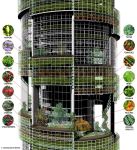The rising cost of fuel and energy impacts agriculture many ways. North American farms use lots of fossil fuel resources to produce incredible yields per acre of land. The same is true of farms in many other industrialized nations. In the developing world energy access is an inhibitor to creating increased crop yields. Fossil fuels are also used in fertilizer production. Industrial farms in North America and Europe need to find ways to reduce hydrocarbon energy dependency and they are. In a recent U.S. report on energy usage by American farmers the total amount of energy directly and indirectly used amounted to 1% of all the energy consumed in the country. The breakdown of energy usage is interesting.

Today land use for agricultural purposes encompasses an area of the planet the size of South America. When human population reaches 9.5 billion by mid-century we will need to add an area equivalent in size to Brazil to feed the increase. If we intensify farming on existing land through better agricultural practices we can mitigate this to some degree. To achieve intensification we will deploy technology in various ways. But technology isn’t the only parameter that can impact agricultural production. Others include access to sufficient fresh water, improved fertilizers, herbicides, and pesticides, and tied into all of this our use of fossil fuels and other energy resources such as renewables.
Today’s industrial farms rely heavily on significant amounts of freshwater. But in the agricultural heartland of the United States and Canada farm water usage increasingly competes with growing urban consumption. The fastest growing cities in the United States are in warm, dry and drying areas of the country. Canada has experienced increased urban growth in its Prairie Region creating similar competition for water. Human consumption of water for drinking, city gardens and waste management means less for the farms and ranches in these areas.
Climate change is also in play. Texas and many of its neighbouring states have experienced prolonged drought for the last year. United States weather records show that from October 2010 to September 2011 New Mexico, Oklahoma, Texas and parts of Louisiana experienced the driest 12 months ever recorded. The drought was further exacerbated from record summer heat. Is this a short-term anomaly or a symptom of a prolonged change that is affecting weather in this region?
Texas and its neighbouring states are not the only prime agricultural areas of the United States that are experiencing weird weather patterns. The most recent National Oceanic and Atmospheric Administration report paints a picture of growing unpredictability in climate patterns leading to higher incidents of extreme weather. And weather can be agriculture’s best friend or worst enemy.
North America is not isolated in experiencing weird weather. Much of Australia has experienced prolonged drought. Monsoon rain patterns may change. The recent prolonged flooding in Thailand is just another example of extreme weather events that may very well be a symptom of climate change.
According to the most recent report from Intergovernmental Panel on Climate Change there is credible evidence for extreme events including a 90 to 100% probability of prolonged heat waves throughout the 21st century, accompanied by increased wind intensity on a global scale and intensifying droughts in South and Central Europe, the Mediterranean basin, central North America, Mexico and Central America, Northeastern Brazil, and Southern Africa. The report forecasts increased frequency of heavy precipitation in many regions of the World with more intense tropical cyclones such as typhoons and hurricanes.
Agricultural production will be impacted. Some regions of the planet currently not used for agriculture may become more suitable habitats for growing crops. But areas currently producing crops and food will have to adapt, or in extreme circumstances, be repurposed.
In any event farming will have to intensify to meet growing demand exerted by population growth. One method of intensification may lead to an entirely new definition of farming. When I grew up in Toronto in the 1950s there were urban farms within the city limits. Not today, but the grow local movement is leading to concepts about growing food in high-rise buildings. A recent article in Scientific American described a one-square-block farm, 30 stories tall, capable of yielding as much food as 2,400 acres of land. Every floor of the building would be used for planting beds or raising small livestock in an environmentally-controlled setting.

Is a vertical farm such as the one pictured above viable? A number of organizations both private and public are in the process of testing the concept.
Creative Concern is undertaking a project in Manchester in the United Kingdom to grow broccoli, tomatoes, onions, carrots, strawberries, mushrooms, chickens, bees and fish in a converted 5-storey building. The farm is expected to be in full production in time to supply food for Manchester’s International Event scheduled for 2013.
Nuvege has developed a vertical farm in Kyoto, Japan, utilizing almost 5,300 square meters (57,000 square feet) of vertical growth environment within a single building. The Nuvege system produces low-bacterial load, high-quality lettuce in a climate and lighting controlled environment that controls water and CO2 levels.
PlantLab, a Dutch company, has developed production units that scale from 100 to 10,000 square meters (1,070 – 107,600 square feet). Each unit is self contained with controlled artificial lighting that can be adjusted for colour, intensity and day length. Air, root and plant temperature are carefully controlled. Irrigation, nutrition, air velocity, air composition, humidity and CO2 levels are managed in a closed cycle environment. Units can be placed anywhere – in a high-rise building, a basement, on a ship at sea, and in any climate. The units rely on advanced automation, control and mathematical modeling systems designed to optimize plant growth. In PlantLab’s design vertical farms implies down as well as up with the company extending its newest facility several stories underground.
Other countries developing vertical farms include South Korea, Singapore, United Arab Emirates, Canada and the United States.







